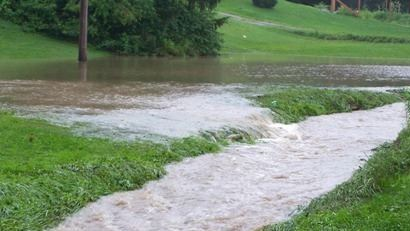In addition to manual entry, Hydrology Studio computes Time of Concentration using one of three methods,
- Lag
- Kirpich
- TR55
Lag Method
This is the TR-20 default method where:


Where:
L = Lag time (hrs)
l = Hydraulic length
S = (1000 / CN) – 10
Y = Average basin slope (%)
CN = Curve number
Kirpich Method
Generally used for natural basins with well defined routes for overland flow along bare earth or mowed grass roadside channels. It is similar to the Lag method but will give shorter times compared to the Lag method.

Where:
Tc = Time of concentration (min)
L = Hydraulic length (ft)
S = Average basin slope (ft/ft)
TR-55 Method (NRCS Velocity Method)
Tc is broken into 3-components or segments as prescribed by TR55 and is also known as the NRCS Velocity method. The final Tc is the sum total of the three components.

Tc = TSheet + TShallow + TChannel (minutes)
Sheet Flow Time
Flow over plane surfaces and typically ranges between 125 to 150 feet.

Where:
n = Manning’s roughness coefficient
L = Flow Length (must be <=100 ft)
P2 = Two-year 24-hr rainfall (in)
S = Land Slope (ft/ft)
Shallow Concentrated Flow Time
After about 100 feet, sheet flow becomes shallow concentrated flow. The computed Average Velocity described below is based on the solution of Manning’s equation with different assumptions for n (Manning’s roughness coefficient) and r (hydraulic radius, ft). For example, per TR55, for for Paved areas, n is 0.025 and r is 0.2; Unpaved areas, n is 0.05 and r is 0.4.
Shallow concentrated flow is assumed not to have a well-defined channel and has a flow depth of 0.1 to 0.5 feet.

Where:
L = Flow Length (ft)
V = Average velocity (ft/s) and

Where:
Cp = 20.328 Paved
Cp = 16.1345 Unpaved, grassed waterways in urban setting
Cp = 9.965 Nearly bare and untilled
Cp = 8.762 Cultivated, straight row crops
Cp = 6.962 Prairie, short-grass
Cp = 5.032 Minimum tillage cultivation, and woodlands
Cp = 2.516 Forest with heavy ground litter
S = Watercourse slope (ft/ft)
Channel Flow Time
Occurs within channels, swales, ditches, streams or even piped systems. Manning’s equation is used to compute velocity.

Where:
L = Flow length (ft)
V = Average velocity (ft/s) and

Where:
V = Average velocity (ft/s)
R = Hydraulic radius (ft) = a/wp
S = Channel slope (ft/ft)
n = Manning’s roughness coefficient
